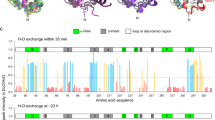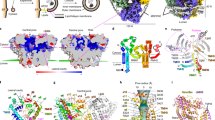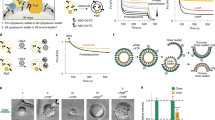Abstract
Atg8, a ubiquitin-like protein, is conjugated with phosphatidylethanolamine (PE) via Atg7 (E1), Atg3 (E2) and Atg12–Atg5–Atg16 (E3) enzymatic cascade and mediates autophagy. However, its molecular roles in autophagosome formation are still unclear. Here we show that Saccharomyces cerevisiae Atg8–PE and E1–E2–E3 enzymes together construct a stable, mobile membrane scaffold. The complete scaffold formation induces an in-bud in prolate-shaped giant liposomes, transforming their morphology into one reminiscent of isolation membranes before sealing. In addition to their enzymatic roles in Atg8 lipidation, all three proteins contribute nonenzymatically to membrane scaffolding and shaping. Nuclear magnetic resonance analyses revealed that Atg8, E1, E2 and E3 together form an interaction web through multivalent weak interactions, where the intrinsically disordered regions in Atg3 play a central role. These data suggest that all six Atg proteins in the Atg8 conjugation machinery control membrane shaping during autophagosome formation.
This is a preview of subscription content, access via your institution
Access options
Access Nature and 54 other Nature Portfolio journals
Get Nature+, our best-value online-access subscription
$29.99 / 30 days
cancel any time
Subscribe to this journal
Receive 12 print issues and online access
$189.00 per year
only $15.75 per issue
Buy this article
- Purchase on Springer Link
- Instant access to full article PDF
Prices may be subject to local taxes which are calculated during checkout






Similar content being viewed by others
Data availability
Microscopic data are deposited online at https://doi.org/10.6084/m9.figshare.24165963. NMR data are deposited online at https://doi.org/10.6084/m9.figshare.23939424. Source data are provided with this paper.
References
Nakatogawa, H. Mechanisms governing autophagosome biogenesis. Nat. Rev. Mol. Cell Biol. 21, 439–458 (2020).
Noda, N. N. & Inagaki, F. Mechanisms of autophagy. Annu. Rev. Biophys. 44, 101–122 (2015).
Noda, N. N. Atg2 and Atg9: intermembrane and interleaflet lipid transporters driving autophagy. Biochim. Biophys. Acta Mol. Cell. Biol. Lipids 1866, 158956 (2021).
Matoba, K. et al. Atg9 is a lipid scramblase that mediates autophagosomal membrane expansion. Nat. Struct. Mol. Biol. 27, 1185–1193 (2020).
Osawa, T. et al. Atg2 mediates direct lipid transfer between membranes for autophagosome formation. Nat. Struct. Mol. Biol. 26, 281–288 (2019).
Maeda, S. et al. Structure, lipid scrambling activity and role in autophagosome formation of ATG9A. Nat. Struct. Mol. Biol. 27, 1194–1201 (2020).
Maeda, S., Otomo, C. & Otomo, T. The autophagic membrane tether ATG2A transfers lipids between membranes. eLife 8, e45777 (2019).
Valverde, D. P. et al. ATG2 transports lipids to promote autophagosome biogenesis. J. Cell Biol. 218, 1787–1798 (2019).
Ghanbarpour, A., Valverde, D. P., Melia, T. J. & Reinisch, K. M. A model for a partnership of lipid transfer proteins and scramblases in membrane expansion and organelle biogenesis. Proc. Natl Acad. Sci. USA 118, e2101562118 (2021).
Noda, N. N., Ohsumi, Y. & Inagaki, F. Atg8-family interacting motif crucial for selective autophagy. FEBS Lett. 584, 1379–1385 (2010).
Kirkin, V. & Rogov, V. V. A diversity of selective autophagy receptors determines the specificity of the autophagy pathway. Mol. Cell 76, 268–285 (2019).
Birgisdottir, A. B., Lamark, T. & Johansen, T. The LIR motif—crucial for selective autophagy. J. Cell Sci. 126, 3237–3247 (2013).
Maruyama, T. et al. Membrane perturbation by lipidated Atg8 underlies autophagosome biogenesis. Nat. Struct. Mol. Biol. 28, 583–593 (2021).
Nakatogawa, H., Ichimura, Y. & Ohsumi, Y. Atg8, a ubiquitin-like protein required for autophagosome formation, mediates membrane tethering and hemifusion. Cell 130, 165–178 (2007).
Xie, Z., Nair, U. & Klionsky, D. J. Atg8 controls phagophore expansion during autophagosome formation. Mol. Biol. Cell 19, 3290–3298 (2008).
Weidberg, H. et al. LC3 and GATE-16 N termini mediate membrane fusion processes required for autophagosome biogenesis. Dev. Cell 20, 444–454 (2011).
Knorr, R. L. et al. Membrane morphology is actively transformed by covalent binding of the protein Atg8 to PE-lipids. PLoS ONE 9, e115357 (2014).
Kaufmann, A., Beier, V., Franquelim, H. G. & Wollert, T. Molecular mechanism of autophagic membrane-scaffold assembly and disassembly. Cell 156, 469–481 (2014).
Harada, K. et al. Two distinct mechanisms target the autophagy-related E3 complex to the pre-autophagosomal structure. eLife 8, e43088 (2019).
Fujioka, Y. et al. Phase separation organizes the site of autophagosome formation. Nature 578, 301–305 (2020).
Noda, N. N. et al. Structural basis of target recognition by Atg8/LC3 during selective autophagy. Genes Cells 13, 1211–1218 (2008).
Matsushita, M. et al. Structure of Atg5.Atg16, a complex essential for autophagy. J. Biol. Chem. 282, 6763–6772 (2007).
Popelka, H. et al. Membrane binding and homodimerization of Atg16 via two distinct protein regions is essential for autophagy in yeast. J. Mol. Biol. 433, 166809 (2021).
Fujioka, Y., Noda, N. N., Nakatogawa, H., Ohsumi, Y. & Inagaki, F. Dimeric coiled-coil structure of Saccharomyces cerevisiae Atg16 and its functional significance in autophagy. J. Biol. Chem. 285, 1508–1515 (2010).
Noda, N. N. et al. Structural basis of Atg8 activation by a homodimeric E1, Atg7. Mol. Cell 44, 462–475 (2011).
Taherbhoy, A. M. et al. Atg8 transfer from Atg7 to Atg3: a distinctive E1-E2 architecture and mechanism in the autophagy pathway. Mol. Cell 44, 451–461 (2011).
Hong, S. B. et al. Insights into noncanonical E1 enzyme activation from the structure of autophagic E1 Atg7 with Atg8. Nat. Struct. Mol. Biol. 18, 1323–1330 (2011).
Yamaguchi, M. et al. Noncanonical recognition and UBL loading of distinct E2s by autophagy-essential Atg7. Nat. Struct. Mol. Biol. 19, 1250–1256 (2012).
Kaiser, S. E. et al. Noncanonical E2 recruitment by the autophagy E1 revealed by Atg7-Atg3 and Atg7-Atg10 structures. Nat. Struct. Mol. Biol. 19, 1242–1249 (2012).
Yamada, Y. et al. The crystal structure of Atg3, an autophagy-related ubiquitin carrier protein (E2) enzyme that mediates Atg8 lipidation. J. Biol. Chem. 282, 8036–8043 (2007).
Yamaguchi, M. et al. Autophagy-related protein 8 (Atg8) family interacting motif in Atg3 mediates the Atg3-Atg8 interaction and is crucial for the cytoplasm-to-vacuole targeting pathway. J. Biol. Chem. 285, 29599–29607 (2010).
Qiu, Y., Hofmann, K., Coats, J. E., Schulman, B. A. & Kaiser, S. E. Binding to E1 and E3 is mutually exclusive for the human autophagy E2 Atg3. Protein Sci. 22, 1691–1697 (2013).
Metlagel, Z., Otomo, C., Takaesu, G. & Otomo, T. Structural basis of ATG3 recognition by the autophagic ubiquitin-like protein ATG12. Proc. Natl Acad. Sci. USA 110, 18844–18849 (2013).
Sakoh-Nakatogawa, M., Kirisako, H., Nakatogawa, H. & Ohsumi, Y. Localization of Atg3 to autophagy-related membranes and its enhancement by the Atg8-family interacting motif to promote expansion of the membranes. FEBS Lett. 589, 744–749 (2015).
Ngu, M., Hirata, E. & Suzuki, K. Visualization of Atg3 during autophagosome formation in Saccharomyces cerevisiae. J. Biol. Chem. 290, 8146–8153 (2015).
Kirisako, T. et al. Formation process of autophagosome is traced with Apg8/Aut7p in yeast. J. Cell Biol. 147, 435–446 (1999).
Mizushima, N. et al. Dissection of autophagosome formation using Apg5-deficient mouse embryonic stem cells. J. Cell Biol. 152, 657–668 (2001).
Suzuki, K., Akioka, M., Kondo-Kakuta, C., Yamamoto, H. & Ohsumi, Y. Fine mapping of autophagy-related proteins during autophagosome formation in Saccharomyces cerevisiae. J. Cell Sci. 126, 2534–2544 (2013).
Matoba, K. & Noda, N. N. Structural catalog of core Atg proteins opens new era of autophagy research. J. Biochem. 169, 517–525 (2021).
Schulman, B. A. & Harper, J. W. Ubiquitin-like protein activation by E1 enzymes: the apex for downstream signalling pathways. Nat. Rev. Mol. Cell Biol. 10, 319–331 (2009).
Toma-Fukai, S. & Shimizu, T. Structural diversity of ubiquitin E3 ligase. Molecules 26, 6682 (2021).
Hamasaki, M., Noda, T. & Ohsumi, Y. The early secretory pathway contributes to autophagy in yeast. Cell Struct. Funct. 28, 49–54 (2003).
Nakatogawa, H. & Ohsumi, Y. SDS–PAGE techniques to study ubiquitin-like conjugation systems in yeast autophagy. Methods Mol. Biol. 832, 519–529 (2012).
Nakatogawa, H., Ishii, J., Asai, E. & Ohsumi, Y. Atg4 recycles inappropriately lipidated Atg8 to promote autophagosome biogenesis. Autophagy 8, 177–186 (2012).
Schindelin, J. et al. Fiji: an open-source platform for biological-image analysis. Nat. Methods 9, 676–682 (2012).
Schneider, C. A., Rasband, W. S. & Eliceiri, K. W. NIH Image to ImageJ: 25 years of image analysis. Nat. Methods 9, 671–675 (2012).
Acknowledgements
We thank Y. Ishii for assistance with protein preparation. This work was supported in part by JSPS KAKENHI grant nos. JP19H05707 (to N.N.N.), JP21K15045 (to T.M.), JP19K16344 (to D.N.), JP19H05708 (to H.N.), JP19K16071 and JP22K06123 (to T.K.), CREST, Japan Science and Technology Agency grant nos. JPMJCR13M7 (to N.N.N. and H.N.) and JPMJCR20E3 (to N.N.N.), AMED-CREST, Japan Agency for Medical Research and Development grant no. JP21gm1410004s0102 (to H.N.) and grants from the Takeda Science Foundation (to N.N.N., T.M. and D.N.), and from the Tokyo Biochemical Research foundation (to N.N.N. and J.M.A.).
Author information
Authors and Affiliations
Contributions
J.M.A., T.M. and N.N.N. designed the research. J.M.A. and T.M. performed GUV experiments. D.N. performed HS-AFM experiments. T.M. performed NMR experiments. C.K., T.K. and H.N. performed budding yeast experiments. J.M.A., T.M., D.N., T.K., H.N. and N.N.N. analyzed data. T.M. and N.N.N. wrote the paper with the inputs from all the authors. N.N.N. supervised the work.
Corresponding author
Ethics declarations
Competing interests
The authors declare no competing interests.
Peer review
Peer review information
Nature Structural & Molecular Biology thanks Helen Walden and the other, anonymous, reviewer(s) for their contribution to the peer review of this work. Peer reviewer reports are available. Primary Handling Editor: Katarzyna Ciazynska, in collaboration with the Nature Structural & Molecular Biology team.
Additional information
Publisher’s note Springer Nature remains neutral with regard to jurisdictional claims in published maps and institutional affiliations.
Extended data
Extended Data Fig. 1 Non-enzymatic effect of conjugation machinery on Atg8-conjugated membrane morphology.
Atg7 (a), Atg3 (b), Atg12–Atg5–Atg16 (c), Atg7 and Atg3 (d), and Atg7 and Atg12–Atg5–Atg16 (e) are applied to Atg8R117C chemically conjugated to PE MCC lipid in a prolate GUV. In (b) and (d), a prolate GUV is tattered by the additions of Atg3 or Atg7 and Atg3, respectively. Experiments were repeated independently five times or more with similar results. DIC, differential interference contrast. Scale bars, 10 μm.
Extended Data Fig. 2 Estimation of area density of Atg8–PE on GUV.
NBD-DOPE in LUV and Alexa Fluor 488-Atg8 in bulk are used for the calibration in fluorescence sensitivity. NBD-DOPE is supposed to be incorporated into GUV stoichiometrically. For area density measurement of Atg8–PE on GUV, Alexa Fluor 488-Atg8 (5.0 μM), Atg7 (2.5 μM), Atg3 (2.5 μM) and Atg12–Atg5–Atg16 (1.25 μM) are introduced to the vicinity of GUV in the presence of MgATP via micropipette. Lipid composition is POPC:POPE:PI:Liss Rhod PE = 59:30:10:1 (mol%). The areal fraction of Atg8–PE at a plateau is estimated to be 6.2% from the fluorescence, corresponding to one Atg8–PE molecule per 161 nm2. Experiments were repeated independently three times with similar results. Scale bar, 10 μm.
Extended Data Fig. 3 NMR analyses of Atg7C, Atg3FR and Atg3HR.
a, 1H-15N HSQC spectral changes of [u-15N]-Atg7C with the titration of Atg8 (left), Atg12–Atg5–Atg16N (middle) and Atg7NTD (right). b, 1H-15N HSQC spectral changes of [u-15N]-Atg3FR with the titration of Atg8 (left), Atg12–Atg5–Atg16N (middle) and Atg7NTD (right). c, 1H-15N HSQC spectral changes of [u-15N]-Atg3HR with the titration of Atg8 (left), Atg12–Atg5–Atg16N (right). Insets show amide signal derived from the side chain in Trp. The protein ratios in the titrations are indicated in each panel, respectively.
Extended Data Fig. 4 Mutational analyses on Atg7 and Atg16.
a, Membrane-bound model of Atg16 predicted by the PPM server38 using the monomeric AlphaFold2 structure of Atg16. Ala mutations denoted as mut 1 and mut 2 were introduced into membrane-facing residues. b, c, Yeast cells were grown to mid-log phase, treated with rapamycin for 4 h, and examined for autophagic activity and the production of Atg8–PE by immunoblotting using anti-myc, anti-GFP, anti-Ape1, anti-Atg8, and anti-HA antibodies. The production of Atg8–PE was examined by urea-SDS-PAGE and immunoblotting. mApe1, mature Ape1; prApe1, Ape1 proform; GFP’, GFP fragment generated by vacuolar degradation of Pgk1-GFP. Experiments were repeated independently twice with similar results. b, Atg16 mutants or truncates at the coiled-coil that showed defects in autophagy activity (Pgk1-GFP procession and Ape1 maturation) also showed defects in Atg8-PE formation. c, The role of Atg7NTD in autophagy activity besides Atg8-PE formation could not be studied since Atg7CTD alone failed to form Atg8-PE even under overexpressing conditions. d, Localization analyses of Atg proteins after lipidation reaction using Atg16 mutants. Data are mean with plots for n = 5 (Atg16D101A E102A), 4 (Atg16mut 1) and 7 (Atg16mut 1+mut 2) GUVs.
Supplementary information
Supplementary Video 1
Shape changes of prolate GUV along with Atg8–PE conjugation reaction. This video was used to generate the images shown in Fig. 1b.
Supplementary Video 2
Another example of shape changes of prolate GUV along with Atg8–PE conjugation reaction.
Supplementary Video 3
HS-AFM observation of the Atg8 conjugation machinery shown in Fig. 4d. Scale bar, 100 nm. Height scale, 0–17 nm.
Supplementary Video 4
HS-AFM observation of the Atg8 conjugation machinery on lipid bilayers shown in Fig. 4e. Scale bar, 30 nm. Height scale, 0–8 nm.
Supplementary Video 5
HS-AFM observation of the glutaraldehyde-treated Atg8 conjugation machinery on lipid bilayers shown in Fig. 4f, left. Scale bar, 50 nm.
Supplementary Video 6
HS-AFM observation of the glutaraldehyde-treated Atg8 conjugation machinery on lipid bilayers shown in Fig. 4f, right. Scale bar, 50 nm.
Source data
Source Data Fig. 2
Graph source data.
Source Data Fig. 3
Graph source data.
Source Data Fig. 4
Graph source data.
Source Data Fig. 5
Graph source data.
Source Data Fig. 6
Graph source data.
Source Data Extended Data Fig. 2
Graph source data.
Source Data Extended Data Fig. 4
Graph source data.
Source Data Extended Data Fig. 4
Unprocessed western blots.
Rights and permissions
Springer Nature or its licensor (e.g. a society or other partner) holds exclusive rights to this article under a publishing agreement with the author(s) or other rightsholder(s); author self-archiving of the accepted manuscript version of this article is solely governed by the terms of such publishing agreement and applicable law.
About this article
Cite this article
Alam, J.M., Maruyama, T., Noshiro, D. et al. Complete set of the Atg8–E1–E2–E3 conjugation machinery forms an interaction web that mediates membrane shaping. Nat Struct Mol Biol 31, 170–178 (2024). https://doi.org/10.1038/s41594-023-01132-2
Received:
Accepted:
Published:
Issue Date:
DOI: https://doi.org/10.1038/s41594-023-01132-2



